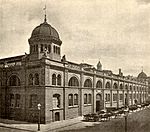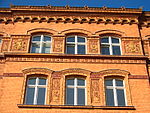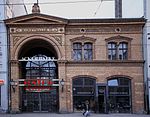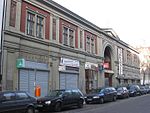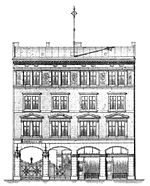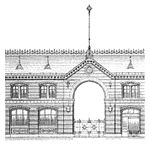Market halls in Berlin
The first covered sales facilities in Berlin with a hall structure were built in the last third of the 19th century. It was the first hall on the Spree, opened in 1867, and further market halls , the construction of which the Berlin City Administration decided in 1883 after a long delay. The 14 halls - now referred to as historical market halls in Berlin - were intended to solve the problem of a hygienic and comprehensive food supply for the rapidly growing Berlin population. In the immediate vicinity of residential areas, the town planners had large market halls built under the responsibility of the town planning officer Hermann Blankenstein and with the assistance of the architect August Lindemann . However, due to competition from the department stores that were being built around the same time , the loss of the small hall dealers, war and the global economic crisis, the first four halls had to close after less than 30 years. In retrospect, the reasons for the failure of the great Berlin market hall concept are also the partially hidden location of the halls, the poor transport connections and the inadequate sales atmosphere. Destruction at the end of the Second World War and rigorous changes in use led to the disappearance of other historical market halls. In 2011 four of them were still in operation as market halls (VI, IX, X, XI).
In the 1950s, a few new market halls were built in the western districts of Berlin, but they lost their importance again over the following decades or were modernized through renovations.
From around 1990 a new trend towards even more complex offers began, not just from small market stall operators - shopping centers or shopping malls emerged as modern market halls based on the American model .
History of the halls from the 19th century
The halls followed a uniform scheme: a high metal support system forms a central nave with side skylights . This is followed by transepts on both sides . The roof rests on cast-iron unclad supports and steel ties . The specific execution was varied according to the local conditions.
The brick façades should ensure a more balanced indoor climate. They are clinkered and richly decorated with yellow and red decorative elements made of terracotta , as medallions or as friezes . In addition to the triumphal arch-like portals to the market hall (on which the numbers and construction times are indicated) there were (further) small shops on the ground floor of neighboring residential buildings, the owners of which lived in the same building. Or the portals were fitted directly into the residential buildings and the hall was then built on the inner courtyards. The ground floor area was divided into small sales areas (on average around four square meters each) and leased to farmers and traders.
The 14 planned market halls were numbered from I to XIV; they were realized in three construction stages - Halls I to IV all opened in May 1886. After they were put into operation, the Royal Police Headquarters announced the following decision on April 28, 1886:
“After the four market halls -
I. in the new Friedrichstrasse, II. In the Lindenstrasse, Friedrichstrasse, III. in Zimmerstrasse and IV. in Dorotheenstrasse have been found
to be suitable, a replacement for the previous ones
1. on Alexanderplatze , 2. on Neuer Markt , 3. on Dönhofsplatze , 4. on Gensdarmen-Markte , according to traffic needs , 5. on the Belle-Alliance-Platz , 6. at the Potsdamer Thore , 7. in the Karlstraße at the corner of Luisenstraße and 8. at the Oranienburger Thore
, the aforementioned eight markets are hereby based on § 69 of the trade regulations in agreement with the municipal authorities on May 3rd of this year, closed at 1 am. "
Halls V to VIII in the outer districts of Berlin were completed by 1888 and the last six market halls were able to go into operation in 1892. The budget for the construction of all the halls was 28 million marks.
The city of Berlin wanted to break up the structures of the existing 20 or so markets in the open air and forced the dealers to use the new halls with regulations and laws. The stall fees were considerably higher than for the old market stalls, but the sales largely made up for that, because it was soon possible to shop on all six working days.
The entire administration of the new market halls was in the hands of the Berlin magistrate, in which Paul Michelet and later Hans von Freyberg, among others, were active in the department set up accordingly (market halls and milk cooling systems). A newly established market police monitored compliance with the strict market regulations. In the period from 1933 onwards, new artistic designs were carried out in the existing market halls, for example the painter Georg Albert Dorschfeldt made frescos in the spirit of the times.
After the end of the Second World War , the partially or fully preserved market halls played an important role in supplying the Berliners. Most of the halls have retained their importance into the 21st century and have been redesigned and modernized several times, as the following list shows.
Overview of the historical halls
The first market hall in Berlin
This market hall was built from 1865 to 1867 on behalf of the Berliner Immobilien-Aktien-Gesellschaft according to plans by the secret building councilor Friedrich Hitzig under the direction of the royal builder Alfred Lent on a former wood storage area between Schiffbauerdamm , Karlsstraße, Friedrichstraße and Panke . On October 1, 1867, it was opened as the first closed market hall (near Friedrichstrasse train station). It was a 84 m long and 62 m wide structure made of iron and glass, with a maximum height of 15.5 m. In addition, there was a small annex between Panke and Markthalle, which was used to sell fish. The market hall was closed again in the spring of 1868 because it was not profitable. Before it was demolished in 1982, the building had undergone many renovations and conversions - as a Prussian arsenal, circus hall, large theater and, most recently, as a variety theater ( Friedrichstadt-Palast ).
Series production of market halls from 1883
The following table provides an overview of the locations, construction times and other details of the 14 historical market halls, illustrated with a picture of the market hall (if available). All components still existing in the 21st century and the three complete halls are under monument protection .
| Number / name / location | Location | when built or opened | Sales area (in m²) / number of stands | Picture and notes |
|---|---|---|---|---|
| I, Central Market Hall Berlin (I and II) ( Location ) |
Berlin-Mitte , on both sides of Kaiser-Wilhelm-Straße (today Karl-Liebknecht-Straße ) near Alexanderplatz | 1884-1886 and -1893 | 16.079 / 1336 13.281 / 776 |
The Central Market Hall I (as it was first called) was the first shopping area to be built according to the municipal building program. It had ice-cold storage rooms in the basement area and its own rail connection for the delivery of goods. By 1893 the extension of the Central Market Hall was built on the opposite side of the street (called Central Market Hall Ia or II). The parts of the central market hall survived the First World War and the economic crisis largely unscathed, and it was not until 1944 that they became ruins. Hall I, poorly rebuilt, helped supply the East Berlin population. Hall Ia was dismantled. In the 1960s the first market hall was also removed. Some parts of it were integrated into a new building in the same place. - After the fall of the Wall there was further renovation work that led to the conversion of the sales facility with the new name "Berlin Carré". |
|
II, Lindenhalle ( Location ) |
Friedrichstadt , Berlin-Mitte, Lindenstrasse 97/98 / Friedrichstrasse 18 | 1884-1886 | 9114/746 | This market hall is located north of Mehringplatz and has entrances from Friedrichstrasse and Lindenstrasse. All buildings including the market hall fell to rubble at the end of the Second World War. While the residential buildings were replaced by new ones based on plans by Hans Scharoun , the market hall could only be rebuilt between 1962 and 1965 in its original form but with new materials. It served as a Berlin flower wholesale market until 2010 . Eventually the Berlin Senate sold the hall for an extension of the Jewish Museum ; the florists were given alternative quarters in the Beusselstrasse wholesale market hall. |
|
III, room hall ( Location ) |
Friedrichstadt , Berlin-Mitte, Zimmerstrasse 90/91 | 1884-1886 | 4843/409 | In 1910 it was closed as a market hall due to the decline in the number of small traders and leased to the catering company Hoffmann & Retschlag. It was converted into the Clou concert hall, and in 1930 it was leased to the publisher Franz Eher . Its publisher produced National Socialist propaganda literature on the premises . In 1942 the former market hall also served as an internment station for arrested Jews ( factory action ). After 1945 the building was converted into a commercial building that is a listed building. A plaque on the facade reminds of the history of the hall. |
|
IV ( Location ) |
Dorotheenstadt , Berlin-Mitte, Reichstagufer and Dorotheenstrasse | 1884-1886 | 3778/364 | The hall had a tunnel to neighboring buildings. It was closed as a market hall in 1913; Parts were integrated into the new building of the post office at the same place. The architects KSP Engel and Zimmermann reconstructed the original market hall facade on behalf of the government for the move of the federal government to Berlin. The complex was expanded to become a press and information office. |
|
V ( Location ) |
Berlin-Tiergarten , Magdeburger Platz | 1886-1887 | 2538/231 | In this hall, too, the number of small businesses fell by the beginning of the 20th century, but it could continue to operate. The hall was damaged in the Second World War and finally demolished in 1956. |
| VI, arable shed ( Location ) |
Berlin-Mitte , Invalidenstrasse at the corner of Ackerstrasse with one entrance each | 1886-1888 | 3546/344 |
The five corridors inside run parallel to Invalidenstrasse; the central aisle is twelve meters high, the two side aisles are six meters wide. The farm hall, hardly destroyed in the war, came into the possession of the Berlin consumer cooperative during the GDR era . It was redesigned for the first time in 1970 under the direction of Klaus Pöschk , with the construction being clad in parts inside. Further redesigns with total renovation took place between 1991 and 2002, during which the original construction was exposed again and the colors and tiles inside were renewed. Its exterior is still largely in its original condition. |
|
VII ( Location ) |
Berlin-Kreuzberg , Dresdner Strasse / Legiendamm | 1887-1888 | 4700/410 | The hall is only partially preserved. These were integrated into a tenement house built around 1900 and now serve as a hotel or restaurant, the name of which recalls the history of the building: "To the small market hall". |
|
VIII ( Location ) |
Berlin-Friedrichshain , Andreasstrasse / Krautstrasse | 1886-3. May 1888 | 5070/532 | The hall was located in an inner block with entrances from Andreasstraße 56, Krautstraße 48a and Grüner Weg (today Singerstraße) 96. It was destroyed at the end of the Second World War and removed in the course of the rubble . |
|
IX, "Markthalle nine" railway hall ( Location ) |
Berlin-Kreuzberg , Pücklerstrasse 34 / Eisenbahnstrasse 42/43 | ? –1891 | 3296/300 | The market hall IX project group, headed by Nikolaus Driessen, Florian Niedermeier and Bernd Maier, has managed to successfully implement the small-scale market hall structure with modern offers. You acquired the hall in May 2011 for 1.1 million euros from the city of Berlin. With the support of the architect Peter Lemburg, a monument-compliant renovation was carried out by the end of September 2011; the redesigned railway market hall was officially re-inaugurated on October 1, 2011. Various food markets and trade fairs as well as cultural events are gladly accepted by the users. The large discounters that are still rented may initially remain in the hall until their contracts expire. |
|
X, Arminiushalle from 2010 in the meantime guild hall , meanwhile again Arminiushalle ( Location ) |
Berlin-Moabit , Arminiusstrasse / Bremer Strasse / Bugenhagenstrasse / Jonasstrasse | 1890-1891 | 4810/425 |
The single-storey market hall, initially also known as the Moabiter Hall , has existed without any major interruptions since its opening. In everyday parlance it is named after the Arminiusstraße running along the hall. The resident dealers have adapted to the respective needs. In addition to numerous retailers, there is a brewery in the spring of 2011 and now also craftsmen with show areas. After a change of ownership, the listed shopping center now traded as a guild hall , now again as the Arminiushalle . more pictures |
|
XI, Marheinekehalle ( Location ) |
Berlin-Kreuzberg , Zossener Strasse / Bergmannstrasse | 1891-15. March 1892 | 2808/278 |
During World War soup kitchen for about 15,000 of Berlin daily, severely damaged in World War II - nevertheless started a new market activity in the summer of 1945 in the cellar. The upper surface served as a depot for a rubble railway until around 1950 . In 1956 the market hall was rebuilt, including the remains. Between 1969, both the owner and the operator changed several times. Since 2011/12, the hall has belonged to three private individuals who are gradually promoting the trade in organic products, foreign specialties and regional specialties from the Uckermark. The areas still leased to discounters will also be redesigned in small parts after the contracts have expired. |
|
XII ( Location ) |
Berlin-Gesundbrunnen , Grüntaler Strasse / Badstrasse 16a | 1890-1892 | 4198/273 | After a dramatic decline in the number of small traders (to under 50) and thus due to inefficiency, the Berlin administration closed the hall in 1898. In the years that followed, up to 1911, the Berlin address books did not show any other uses; it was simply called “Fiskus”. In 1915, a “Restaurant zum Kastanienwäldchen” was named, which indicates that the courtyard building was re-used. The market hall disappeared in 1920 because the house number has not existed since then. |
| XIII ( Location ) |
Berlin-Prenzlauer Berg , main entrance Wörther Straße 45 | 1890-1892 | 5095/393 | The indoor market hall XIII was surrounded by the streets Franseckystraße (north), Treskowstraße (today side entrance Treskowstraße 11) (east), Wörtherstraße (south) and Schönhauser Allee (west). After the number of leased market stalls had decreased to around 100 by 1910, the hall was closed in 1910. In the Berlin address book it is listed as Markthalle XIII until 1935 (a corresponding use has not yet been determined), after which it is only listed as owned by the city of Berlin. The hall was destroyed in the Second World War. In their place there are now sports fields and a school, the front building has completely disappeared. |
| XIV ( Location ) |
Berlin-Gesundbrunnen , Dalldorfer Straße 21/22 (from 1919 Schönwalder Straße 19) east of Wedding-Platz | 1890-1892 | 4057/352 | In 1910 the market hall is listed in the address book under Dalldorfer Straße, owned by the City of Berlin. The street was renamed in 1919 and the houses were renumbered, so market hall XIV can now be found under number 19, until 1925. From 1930 it is no longer in the address book, but a market hall manager and a savings bank are listed. |
Further market halls between 1900 and 1945
- Markthalle Tegel : opened in 1908 as a private weekly market with more than 180 stalls by August Prenzel. At the end of the Second World War, the market was largely destroyed, the combustible materials found their way into the stoves of the residents. Nevertheless, market operations could soon start again. In 1958 the site was given a fixed roof on iron girders for the first time. When the founder's son Walter Prenzel took over management, he was finally able to build a completely new hall, which opened on March 23, 1972. The plant was modernized several times (including in 1987 and in the 1990s). To date, 50 medium-sized dealers with around 200 employees have been supplying the residents of Tegel or their visitors with fresh, everyday goods. The Tegel market hall is currently being rebuilt. The traders moved into the house opposite.
- In 1929 the first market hall for wholesale was added.
- Ringbahnhalle Frankfurter Allee : The market hall at the Frankfurter Allee S-Bahn station, originally built as a cinema in 1915, was an important shopping center in East Berlin until the end of the GDR . The hall was demolished in 1993. The Ring Center I is in its place today.
- Großmarkthalle Beusselstraße , 1936: According to plans by Richard Ermisch as a storage and transshipment point for the livestock wholesalers.
Market halls between 1950 and 1990
Other market halls in Berlin in the classic sense with individual market stalls were in Berlin-Wedding ("Müllerhalle"), Müllerstrasse 123/125 at the corner of Kongostrasse and in Berlin-Reinickendorf ("Residenzhalle"), Residenzstrasse 34, all opened in 1950.
- The Müllerhalle ("Markthalle für Jedermann") has been gradually emptied since 2007. It was in dire need of renovation and was demolished. In their place a new building was built in the style of modernism , which was opened under the name Neue Müllerhalle by the food retail chain Kaufland in December 2013.
- The residence hall had a sales area of around 1800 m². The former listed hall burned down completely on the night of May 26-27, 2001. A cause of the fire could not be found. Reconstruction was decided in autumn 2001; the symbolic groundbreaking for the new glass shopping arcade took place on November 21, 2001. At costs of around 2.5 million euros, Priva Liegenschaftsverwaltungs GmbH had the new residential hall built according to plans and under the direction of the architect Marcel Gallinge, now as Called Residenzpassage . It offers less retail space (16 stands), but there is parking on the roof. It received criticism from the dealers involved and some customers that "many would have wished for a real market hall again instead of the glass mall." - The investor defended the new building, however: "The market hall principle in Berlin no longer corresponds to today's zeitgeist."
- Europa Center , 1965
- Forum Steglitz , opened in 1970. The rear part of the ground floor was used as a market hall until 2005.
New market halls as shopping centers from the 1990s and in the 21st century (selection)
From the 1990s onwards, large shopping centers were built following the American model or existing facilities were converted accordingly (the dates indicate the opening year). The now almost 60 shopping centers include (as of June 2017):
- Gropius Passagen , 1994
- Linden Center , 1995
- Bright center , 1997
- Gesundbrunnen-Center , 1997, in the district of Berlin-Gesundbrunnen .
- Tempelhof market hall , 1998
- Potsdamer Platz Arcades , 1998
- Ring Center (three parts: 1995, 1997, 2007)
- Eastgate , 2005
- Alexa , 2007
- Tempelhofer Hafen shopping center , 2009
- Markthallen am Gleisdreieck (MaG), Luckenwalder Strasse 4-6, 2010:
The sales facility is located in the renovated halls of the Luckenwalder Strasse post station in Berlin-Kreuzberg, which was decommissioned in 1997 . - Mall of Berlin near Leipziger Platz , 2014
- Bikini Berlin , the Bekinihaus since it was converted into a shopping mall, 2014
- East Side Mall in the Berlin-Friedrichshain district , 2018
See also: List of large shopping centers in Germany
literature
- August Lindemann : The market halls of Berlin. Your structural systems and operating facilities on behalf of the magistrate. Springer, Berlin 1899.
- Erich Rindt: The market halls as a factor in Berlin's economic life . Dissertation, Friedrich-Wilhelms-Universität Berlin, Berlin 1928
- Main Market Administration of the City of Berlin (Ed.): 50 Years of the Berlin Market Hall , Berlin 1936
- Eckart Bollmann and Konrad Kuhnt (eds.): Berliner Markthallen , Herford 1983
- Thorsten Knoll: Berlin market halls . Berlin Reminiscences No. 69. Haude & Spenersche Verlagbuchhandlung, Berlin 1994, ISBN 3-7759-0392-5
Web links
Individual evidence
- ↑ a b c d e Uwe Spiekermann: Basis of the consumer society. Origin and development of modern retail trade in Germany 1850–1914 (= series of publications for the journal for corporate history. Vol. 3). C. H. Beck, Munich 1999, ISBN 3-406-44874-7 , p. 180/181, excerpt from Google , accessed on February 11, 2011.
- ^ Acta of the city council assemblies in Berlin, period 1853–1897. In: A Rep 000-02-01, No. 918 in the Landesarchiv Berlin, quoted in the minutes of the meeting from May 1886.
- ↑ Berlin market halls . In: Berliner Zeitung , October 25, 1994.
- ↑ Municipal administration . In: Berliner Adreßbuch , 1917, part 2, p. 132 (compilation of the 12 remaining urban market halls with addresses).
- ↑ Lent, A. In: Allgemeiner Wohnungs-Anzeiger together with address and business manual for Berlin , 1868, part 1, p. 379. “Kgl. Baumeister, Sigismundstrasse 6-9 ”.
- ↑ Thorsten Knoll: Berliner Markthallen (= Berlinische Reminiscences 69). Haude and Spener, Berlin 1994, ISBN 3-7759-0392-5 .
- ↑ Friedrichstrasse 18 . In: Berliner Adreßbuch , 1917, part 3, p. 249 (Markthalle II; the crafts school I, the meat inspection station II and the tax acceptance office II are also given at the same address).
- ↑ Packing in the flower wholesale market. Last day in the Kreuzberger Halle before moving to Moabit. Almost half of the current dealers will not be represented in the new location. In: Der Tagesspiegel , May 15, 2010
- ↑ Market Hall III
- ↑ Architectural monument market hall IV
- ^ Photo of the inside of the market hall by Hermann Rückwardt. From: Architekturmuseum der TU Berlin.
- ↑ Farm shed . In: District lexicon of the Luisenstädtischer Bildungsverein
- ↑ Institute for Monument Preservation (Ed.): The architectural and art monuments of the GDR. Capital Berlin . tape 1 . Henschelverlag, Berlin 1984, p. 309 f .
- ^ Ackerhalle ( Memento of March 8, 2011 in the Internet Archive ) berlin.de; Retrieved March 15, 2011.
- ↑ Uwe Aulich: The farm hall opens again. In: Berliner Zeitung , August 14, 2002.
- ↑ Architectural monument market hall VI
- ↑ Architectural monument market hall X
- ↑ City map from 1893 with the location of Markthalle VIII. Accessed on May 15, 2019 .
- ↑ Ralf Schmiedecke: Berlin-Friedrichshain (= the series archive images ). Sutton, Erfurt 2006, ISBN 3-86680-038-X , p. 56.
- ^ Initiative Markthalle 9 , accessed on March 16, 2011.
- ↑ Architectural monument market hall IX
- ^ Renaissance of the market halls . ( Memento from June 4, 2012 in the Internet Archive ) In: taz , October 1, 2011
- ↑ Architectural monument market hall X
- ↑ Homepage of the Zunfthalle Arminiusmarkthalle
- ↑ a b history , homepage of the Marheineke market hall, accessed on February 1, 2016.
- ↑ Angela M. Arnold, Gabriele von Griesheim: rubble, railways and districts. Self-published, Berlin 2002, ISBN 3-00-009839-9 , pp. 117ff.
- ↑ Badstrasse 15a . In: Berliner Adreßbuch , 1910, part 3, p. 39.
- ↑ Badstrasse 16a . In: Berliner Adreßbuch , 1915, part 3, p. 40.
- ^ Berlin address book from 1920
- ↑ Dalldorfer Strasse . In: Berliner Adreßbuch , 1910, part 3, p. 152.
- ^ Homepage Markthalle Tegel with facts about the history , accessed on March 17, 2011.
- ↑ New Tegel Center. The conversion is approved , opened on berliner-woche.de, Markthalle Tegel ( memento of the original from December 1, 2017 in the Internet Archive ) Info: The archive link was automatically inserted and not yet checked. Please check the original and archive link according to the instructions and then remove this notice. , on tegel.kietzekatze.berlin.
- ↑ Historic market hall. In: For you. No. 11, 1984, ISSN 0323-5947 , p. 17.
- ↑ View drawing by R. Ermisch of the Beusselstrasse wholesale market hall. From: Architekturmuseum der TU Berlin.
- ↑ Half of the market stalls are empty. In: Berliner Morgenpost , June 10, 2008.
- ↑ Kaufland opens controversial new building on December 5th. In: Berliner Woche , December 2, 2013.
- ↑ Major fire: residential hall in Reinickendorf destroyed. In: Tagesspiegel of May 27, 2001.
- ↑ The old Resi becomes the Residenzpassage. In: Berliner Zeitung , November 22, 2001.
- ↑ Shopping center in Berlin at berlinonline.de, accessed on June 7, 2019.
- ^ Website of the Gesundbrunnen Center
- ^ History ( memento from September 13, 2010 in the Internet Archive ) Markthallen am Gleisdreieck, accessed on March 16, 2011.


